April 6, 2025
Marketing Content Automation: The Future of Scalable Content Creation
The rapid advancements in artificial intelligence (AI) and automation have led to a significant transformation in digital marketing. Gone are the days of manual content generation, distribution, and analysis.
These technologies are transforming digital marketing by streamlining content creation. Therefore, for businesses to adapt in today’s evolving and competitive digital world, they have to leverage AI technology.
Marketing content automation is emerging as the solution to scalable content creation. It streamlines workflows, saves time and resources, and enhances efficiency.
Whether you are operating an old or new business, this article is for you. We will explore marketing automation in detail: the meaning, benefits, content automation tools, and real-life examples for scalable content creation in digital marketing.
What Is Marketing Content Automation In Digital Marketing?
Marketing content automation is the use of technology, such as artificial intelligence (AI), machine learning, and software, to streamline, distribute, manage, and optimize content creation. These tools help to streamline the various aspects of the content creation process by automating workflows and repetitive tasks to improve efficiency and scalability in content marketing.
Marketing content automation helps with tasks like content generation, scheduling, distribution, personalization, and performance analysis, reducing human effort and saving time and cost. Content automation can be applied to various types of content, such as articles, blogs, social media posts, videos, and images.
How to Successfully Implement Marketing Content Automation
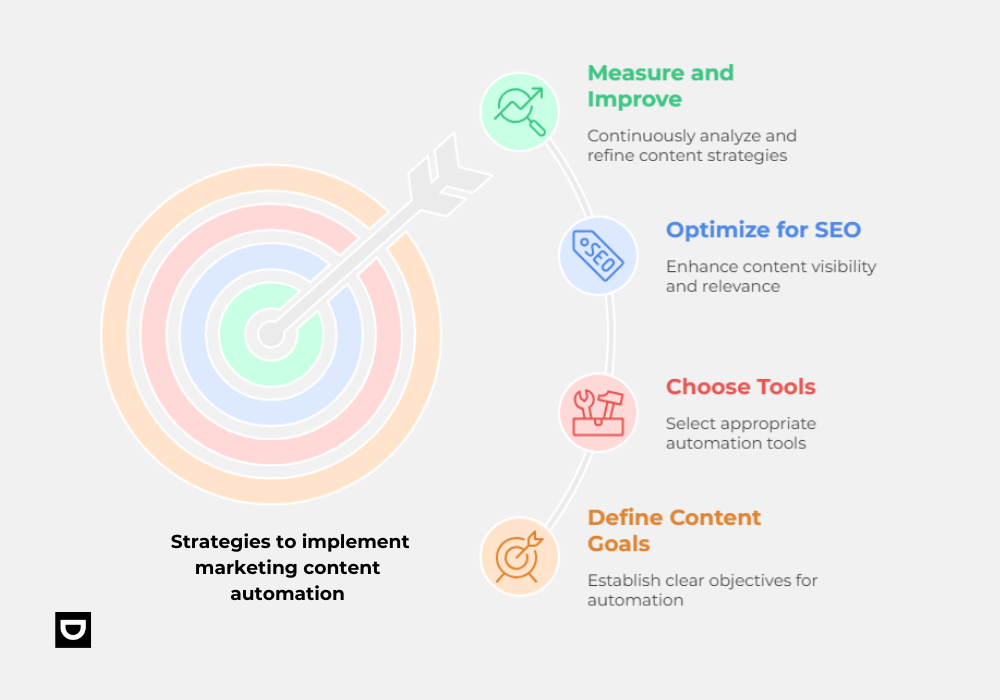
Now that we’ve seen the benefits that marketing content automation offers, it is important to effectively leverage these AI-driven solutions. A successful implementation requires a structured approach. The following are strategies to successfully implement marketing content automation:
1. Define Your Content Goals
Before automating your content creation process, clearly define your goals and objectives. Defining goals ensures that automation efforts align with your business objectives. Identify areas where AI-powered solutions are needed, such as content creation, personalization, distribution, optimization, analysis, or content performance.
A clearly defined goal lays the foundation for selecting the right strategies tailored to your needs. For example, if lead generation is the primary goal, you may focus on automating email campaigns and personalized content. If brand awareness is the priority, automation can assist in scaling social media posts and blog content distribution.
You can ask yourself these questions:
- What do you want to achieve with content creation?
- Do you want to increase engagement, website traffic, or generate leads?
2. Choose the Right Content Automation Tools
Once you’ve clearly defined your goals, the next step is to choose the right content automation tool. The selection should depend on your specific content needs (AI content creation, scheduling, personalization, blog automation, email marketing, etc.).
For your marketing content automation, Dumpling.ai is a powerful tool for blog post generation, email campaigning, social media posts, and SEO enhancements. Choosing tools that integrate seamlessly with your existing marketing stack enhances workflow efficiency.
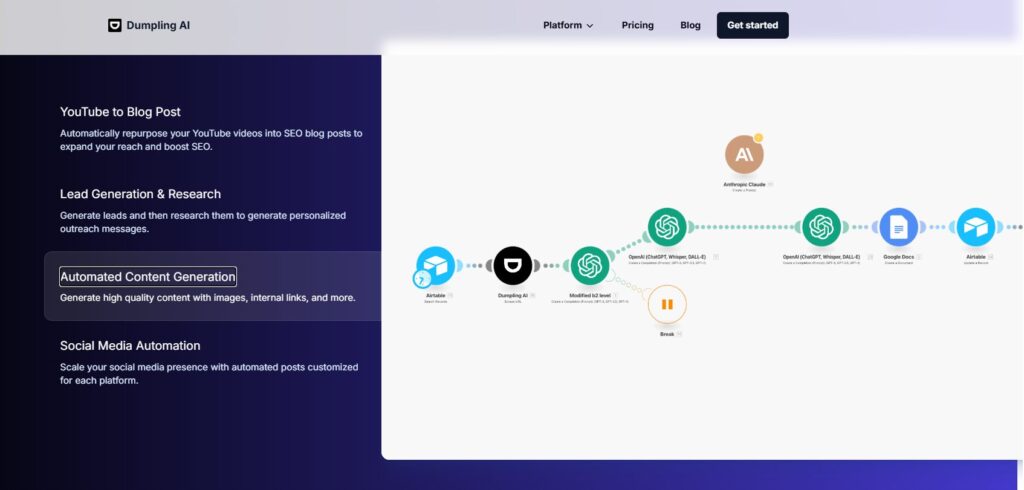
3. Optimize for SEO
After automating your content creation, you must proceed to optimizing the content. SEO enhancement is a critical factor for content success.
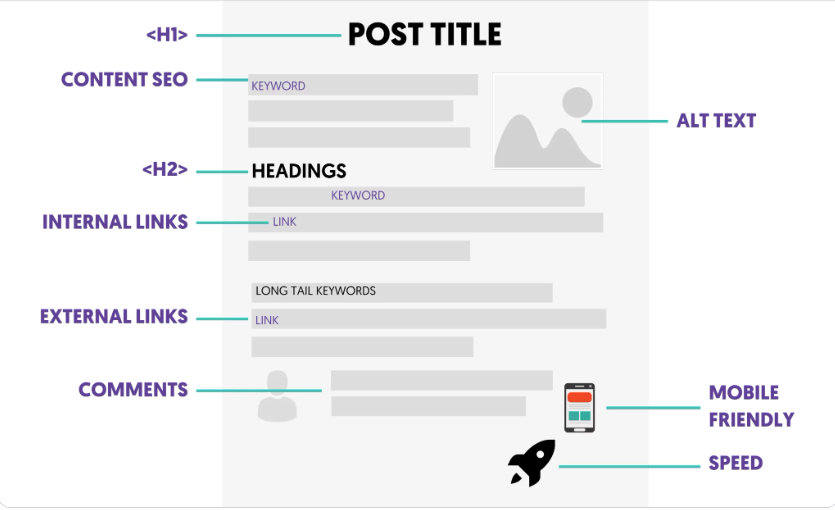
Automated content must be optimized to rank high on search engines and reach the right audience. You can optimize your content by doing the below:
- Keyword Research and Implementation: Use AI-based SEO tools to search for relevant keywords that match user search intent. Incorporate primary and secondary keywords naturally into headings, subheadings and body text.
- On-Page SEO Techniques
- Title Optimization: Ensure automated content includes compelling, keyword-rich titles.
- Meta Descriptions: Use automation tools to generate engaging meta descriptions that improve click-through rates.
- Internal Linking: Automate internal link suggestions to improve site navigation and SEO value.
- Alt Text for Images: AI-powered tools can add SEO-friendly alt text to images, enhancing accessibility and search rankings.
- Content Structuring for Readability
- Break content into digestible sections using H1, H2, and H3 tags.
- Use bullet points, numbered lists, and short paragraphs for better readability.
- Ensure content flows naturally and aligns with user expectations.
SEO optimization ensures that automated content reaches a wider audience while providing value by matching search intent.
4. Measure and Improve
Once content automation is in place, it’s essential to track performance and make improvements based on data-driven insights. Here is what to do:
- Analyze Content Performance
- Use Google Analytics to track page views, time on page, and bounce rates.
- Monitor engagement metrics such as social shares, likes, and comments.
- Evaluate email marketing success by tracking open rates, click-through rates, and conversions.
- Leverage AI-Driven Insights
- AI-powered analytics tools can identify trends and predict future content performance.
- Heatmaps and user behavior tracking can highlight areas for content improvement.
- Continuously Optimize Content
- Update automated content based on performance insights to keep it relevant.
- A/B test automated emails, headlines, and call-to-actions to determine what resonates most with your audience.
- Refine automation workflows to enhance personalization and audience targeting.
By continuously analyzing and improving automated content strategies, businesses can maximize the effectiveness of their marketing automation efforts.
Marketing Content Automation Tools for Scalable Content Creation
Marketing content automation helps simplify the creation, distribution, management, optimization, and analysis of content while maintaining high-quality content. These tools leverage artificial intelligence, machine learning, and data analytics to automate tasks like content generation, social media scheduling, email marketing, and SEO enhancements.
To make content automation easier, it is crucial to select the right tools. A well-designed content automation tool can make the content production process seamless and more manageable. Some of the tools to enhance workflow efficiency include:
1. Dumpling.AI
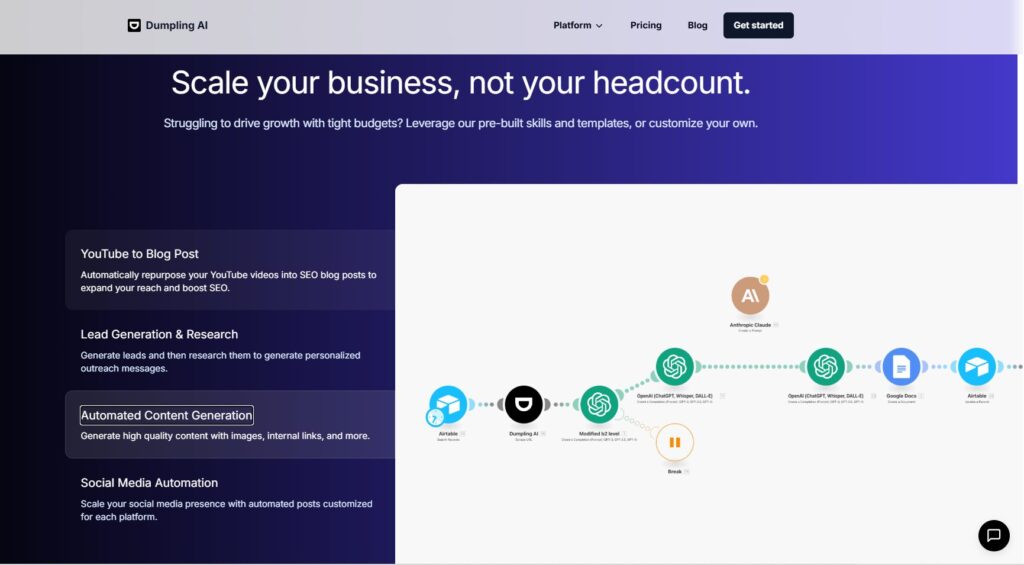
Dumpling.ai is one of the best tools for marketing content automation. It offers an advanced content automation tool that streamlines content creation, optimization, and distribution. Known for leveraging AI-based insights, it automates blog posts, social media posts, email campaigns, and SEO enhancements.
Dumpling.ai helps personalize content based on individual user preferences, history, interests, and interactions. By reducing manual effort, Dumpling.ai empowers businesses to focus on strategy while maintaining a steady flow of high-quality content. With its intelligent automation features, brands can enhance engagement, boost visibility, and drive sustainable growth in an increasingly competitive digital landscape.
2. AI Content Generation Tools
- Jasper AI: Jasper AI is an advanced AI-driven content generation tool designed to help marketers, bloggers, and businesses create high-quality, SEO-friendly content in a fraction of the time. It helps to generate blog posts, social media captions, email campaigns, and ad copies.
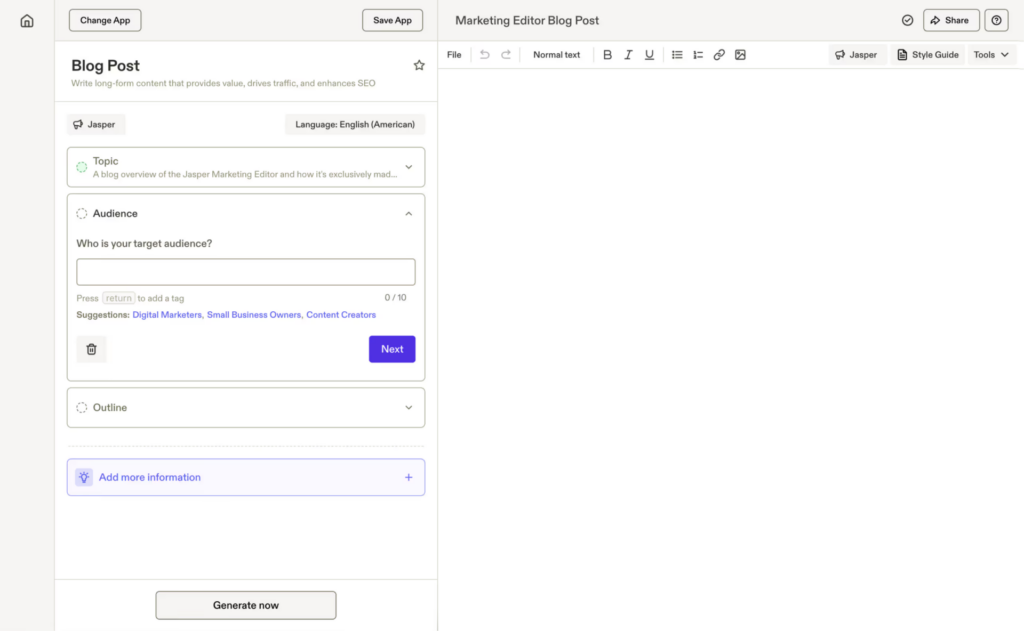
Some of the key features are SEO enhancements, multiple content formats and tone customization. Japer AI saves time by automating content creation. It is also ideal for scaling content production across multiple platforms.
- Writesonic: Writesonic is another AI-powered content generation tool that specializes in creating compelling marketing copy, blog posts, and landing page content. It is widely used by startups, e-commerce brands, and content marketers.
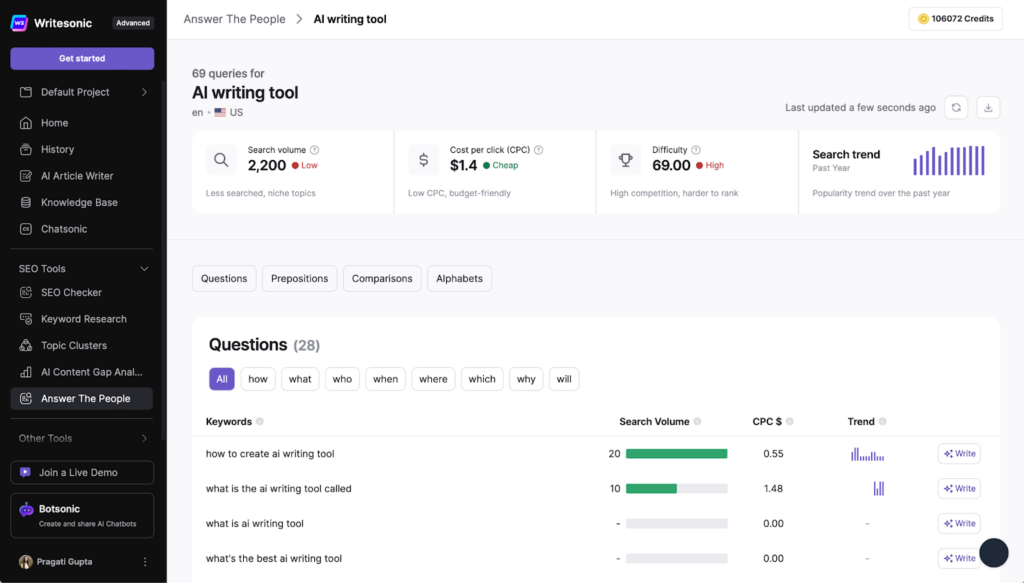
Some of its key features are blog post generator, landing page copy, and AI-powered rewriting.
3. Social Media Automation
- Buffer: Buffer is a social media automation tool that enables businesses to schedule, analyze, and optimize social media posts across multiple platforms. It simplifies content distribution while ensuring consistent engagement. Buffer also maintains a consistent online presence with minimal effort.
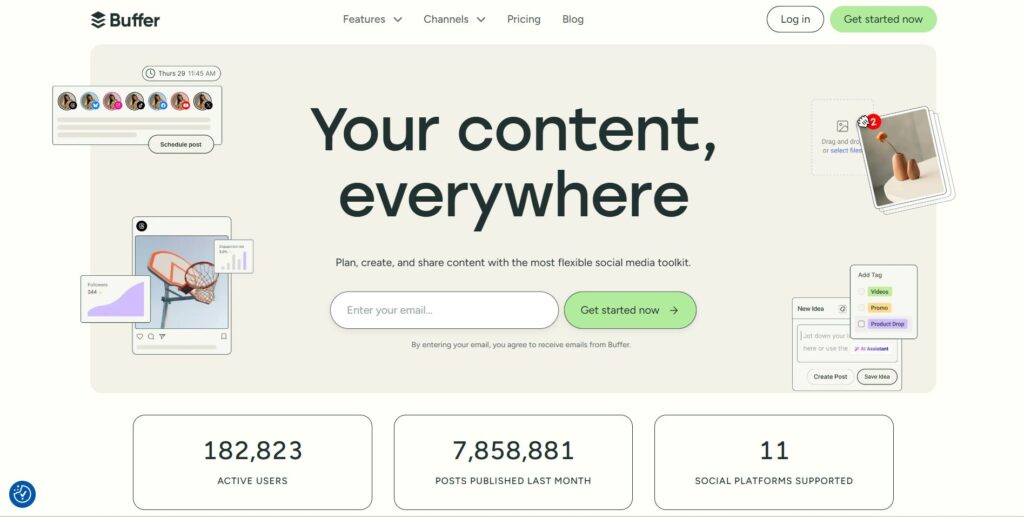
Some of its key features are post scheduling, performance analytics, collaboration tools, and hashtag suggestions.
- Hootsuite: Hootsuite is another social media automation tool that provides scheduling, monitoring, and engagement features for businesses looking to streamline their social media efforts.
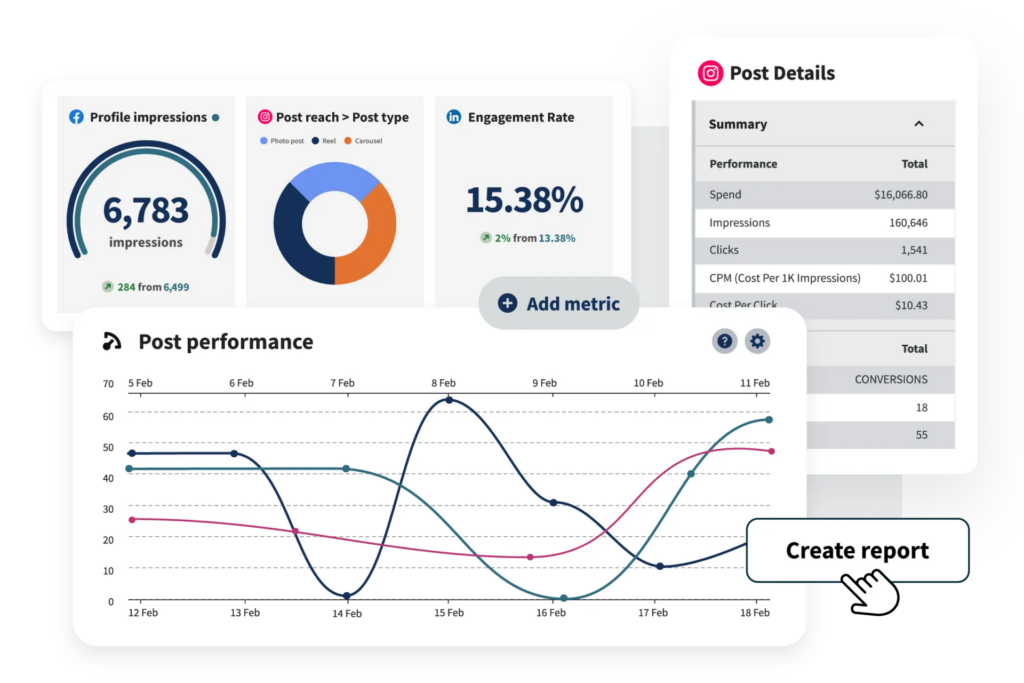
Hootsuite can be used for bulk scheduling, social listening, engagement management, and detailed analytics reports. It saves time by managing multiple accounts from one dashboard and improves audience engagement with automated responses and monitoring.
4. SEO Optimization & Content Structuring
- Surfer SEO: Surfer SEO is an AI-powered content optimization tool that helps marketers and writers improve their website’s search rankings by analyzing top-performing content.
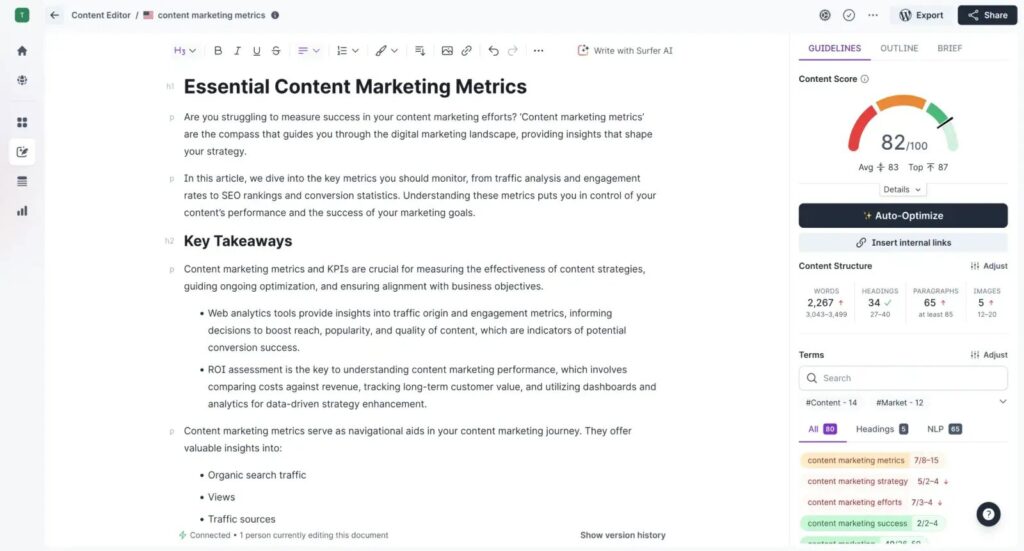
It can be used for automating content production processes such as keyword research, content structure analysis, SEO audit, and real-time scoring.
5. Email Marketing & CRM Automation
- Klaviyo: Klaviyo is an AI-driven email and SMS marketing automation platform, primarily designed for e-commerce businesses. It offers advanced segmentation, predictive analytics, and highly personalized campaigns.
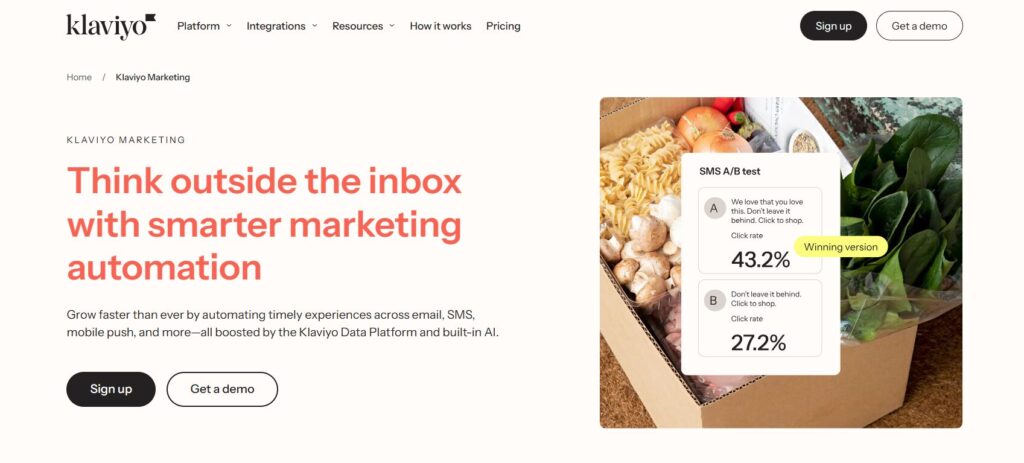
It is used for e-commerce integrations, predictive analytics, and SMS marketing.
6. Content Scheduling and Management
- HubSpot: This is a leading marketing automation platform that simplifies content scheduling and management. It allows marketers to plan, create, and distribute content seamlessly across multiple channels.
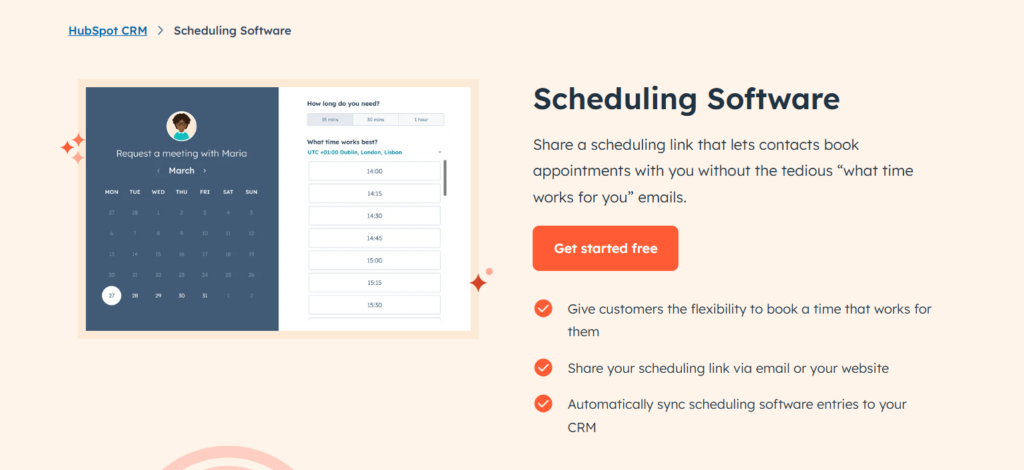
The key features are automated content publishing, a content calendar, and multi-channel distribution. HubSpot enhances efficiency by reducing the need for manual posting, freeing up time for strategy and creativity.
7. Analytics and Performance Tracking
- Google Analytics: Google Analytics is a widely used tool that tracks website traffic, user behavior, and content performance. It provides real-time data on audience demographics, session duration, and bounce rates.
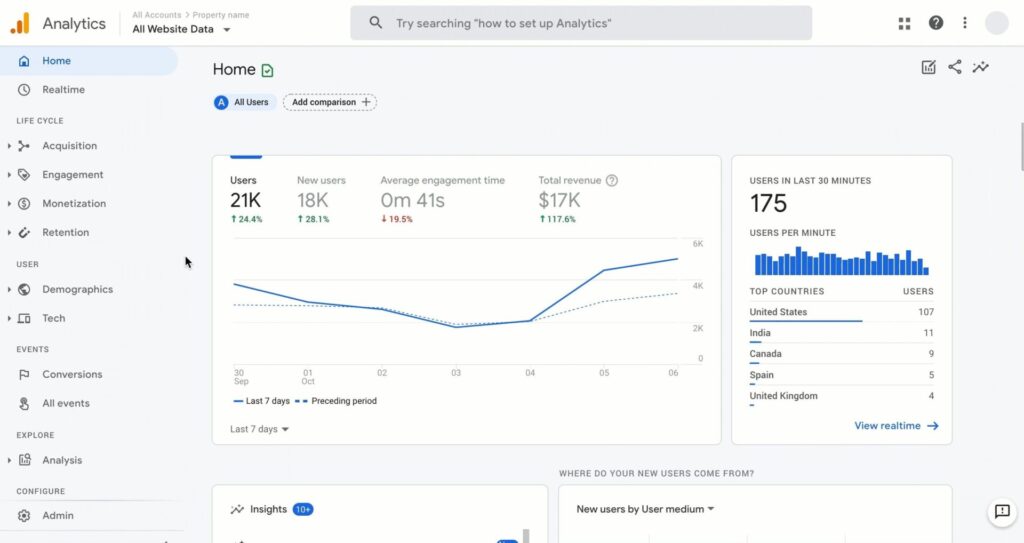
It tracks website visitors and their interactions and identifies top-performing content. Google Analytics also provides insights into user demographics and engagement.
Real-Life Examples of Marketing Content Automation
Here are some real-life examples of marketing content automation in action:
1. Netflix – Personalized Content Recommendations
Netflix uses AI-driven automation to analyze viewer preferences and suggest content tailored to individual users. This keeps engagement high and reduces churn.
2. HubSpot – Automated Email Campaigns
HubSpot’s marketing automation platform helps businesses send personalized email sequences based on user behavior, ensuring timely follow-ups and increased conversions.
3. Amazon – Dynamic Product Recommendations
Amazon leverages automation to suggest products based on browsing history, past purchases, and customer preferences, boosting sales effortlessly.
4. Coca-Cola – AI-Powered Social Media Marketing
Coca-Cola automates content creation and social media engagement using AI, ensuring timely responses and data-driven campaign strategies.
5. Shopify – Automated Content for E-commerce Stores
Shopify store owners use AI tools to generate product descriptions, blog posts, and ads automatically, saving time while maintaining brand consistency.
Benefits of Marketing Content Automation
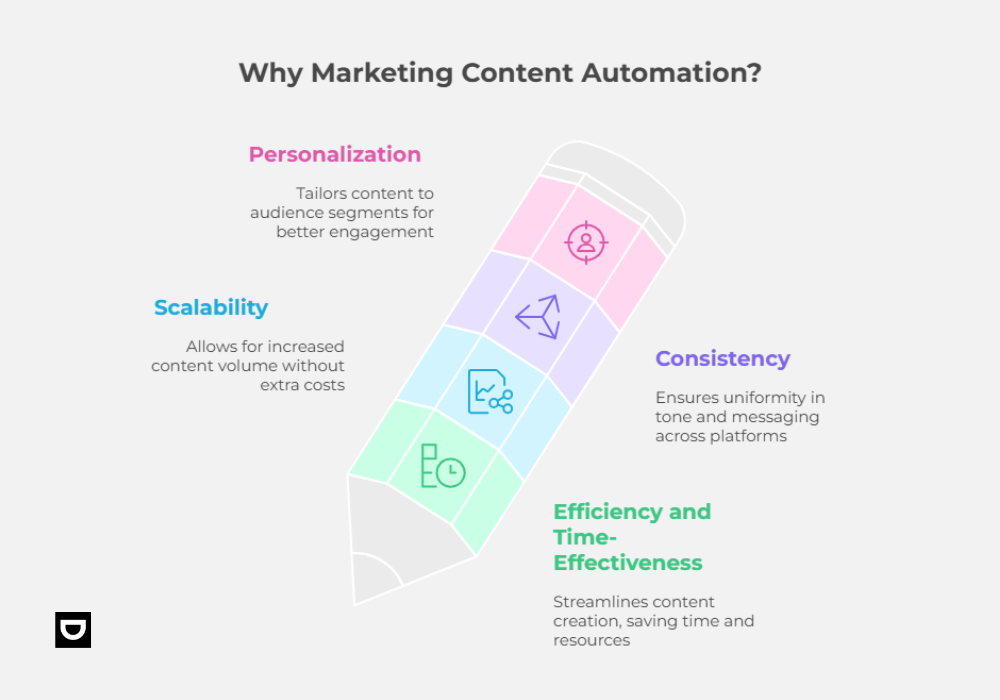
In the digital landscape, marketing content automation is crucial in the content creation process because of the many benefits that it offers. When incorporated, it helps to generate content faster, more efficiently, and with a higher degree of personalization. Here are the benefits:
Efficiency and Time-Effectiveness
Marketing content automation is significant for its ability to streamline the content creation process. Every step in content creation can be automated.
Content automation significantly minimizes the time, resources, and effort spent on manual content creation and management. High-quality content is generated in seconds. This benefit allows content creators to focus on more complex and higher-value tasks, such as creative ideation. It not only reduces time but also generates content faster and more efficiently while maintaining quality and relevance.
Scalability
Scalability is one of the key benefits of marketing content automation. It refers to the ability to efficiently increase the volume of content produced and distributed without a corresponding increase in time, resources, or cost.
For businesses seeking to expand their content marketing efforts and reach a broader audience, content automation is the answer. It can help generate, distribute, and manage large amounts of content across various platforms without compromising on quality and consistency.
With automated tools and algorithms, it’s easier to meet increasing demands, adapt to changing market trends, or expand to new markets without overburdening the content teams.
Consistency
By leveraging content automation, your content creation process remains consistent across all channels and platforms. Marketing content automation follows predefined rules and configurations. Therefore, the risk of errors or inconsistencies in content production is reduced.
There is consistency in tone, style, and messaging across various content platforms. Through post scheduling, businesses deliver content regularly without delays, resulting in high engagement and quality content.
Personalization
Marketing content automation can create highly personalized content to target audiences at scale. Automated content tools can segment audiences based on individual user interaction, behavior, demographics, and preferences, allowing you to connect with your audience on a deeper level. When content is tailored to individual interests, it increases satisfaction and engagement.
Conclusion
In the digital marketing landscape, AI technologies are streamlining content workflows. If you’re seeking to enhance efficiency, engagement, and scale content creation, marketing content automation is the best solution.
By clearly defining goals and selecting the appropriate marketing content automation tools, businesses can seamlessly create high-quality content that is consistent and relevant. Explore Dumpling.ai to start and unlock new growth opportunities.




